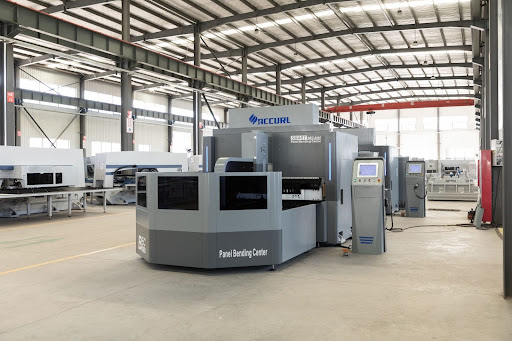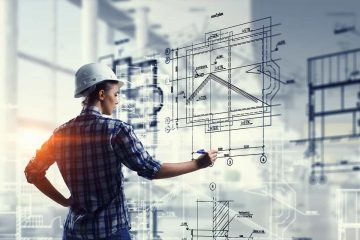In the dynamic landscape of modern manufacturing, efficiency, precision, and adaptability are paramount. Press brake machines stand at the forefront of this technological evolution, revolutionizing the way metal fabrication is conducted.
From automotive components to intricate architectural elements, press brakes play a pivotal role in shaping diverse industries. This article delves into the intricacies of press brake machines, exploring their significance, functionality, and impact on streamlining production processes.
Understanding Press Brake Machines
Press brake machines are mechanical devices used to bend sheet metal into various shapes and forms. They utilize a hydraulic or mechanical mechanism to apply force on a metal workpiece, causing it to bend along a predetermined axis.
Press brake machines are equipped with a variety of tools and dies, allowing for precise bending according to design specifications.
Components of a Press Brake Machine
Press brake machines consist of several essential components:
- Frame: The frame provides the structural support for the machine and houses the hydraulic or mechanical systems responsible for generating bending force.
- Ram: The ram, or the upper beam, is the moving part of the press brake that applies force to the workpiece. It can move vertically to exert pressure on the metal sheet.
- Bed: The bed serves as the base of the machine and provides a flat surface on which the metal sheet rests during the bending process.
- Backgauge: The backgauge is a device used to position the metal sheet accurately before bending. It ensures consistency and precision in the bending operation.
- Hydraulic System: In hydraulic press brakes, hydraulic cylinders are employed to generate the force required for bending. These systems offer high power and precision control over the bending process.
- Control System: Modern press brake machines are equipped with sophisticated control systems that allow operators to input bending parameters such as angle, bend length, and material thickness. These systems contribute to automation and efficiency in production.
Types of Press Brake Machines
Press brake machines come in various types, each suited for specific applications and manufacturing requirements:
- Mechanical Press Brakes: Mechanical press brakes utilize a flywheel and clutch mechanism to generate bending force. While they are known for their high-speed operation, they may lack the precision and control offered by hydraulic systems.
- Hydraulic Press Brakes: Hydraulic press brakes use hydraulic fluid to generate bending force, offering precise control over the bending process. They are ideal for applications requiring high accuracy and versatility.
- Synchronized Press Brakes: Synchronized press brakes feature multiple hydraulic cylinders working in synchronization to ensure uniform bending along the entire length of the workpiece. This results in consistent bends with minimal deformation.
- CNC Press Brakes: CNC (Computer Numerical Control) press brakes are equipped with computerized control systems that allow for programmable bending operations. They offer high precision, repeatability, and automation capabilities, making them ideal for complex bending tasks.
Applications of Press Brake Machines
Press brake machines find widespread applications across various industries, owing to their versatility and ability to work with a wide range of materials and thicknesses. Some common applications include:
1. Sheet Metal Fabrication
Press brake machines are extensively used in sheet metal fabrication processes to bend and form metal sheets into components for various products.
From enclosures and chassis to brackets and panels, press brake machines play a crucial role in shaping sheet metal parts with precision and efficiency.
2. Automotive Industry
In the automotive industry, press brake machines are employed in the manufacturing of vehicle components such as body panels, frames, brackets, and exhaust systems. These machines enable the production of complex shapes and contours required for modern automotive designs.
3. Aerospace and Aviation
In aerospace and aviation manufacturing, where precision and quality are paramount, press brake machines are used to fabricate structural components, engine parts, and aircraft interiors.
Their ability to work with high-strength materials such as aluminum, titanium, and stainless steel makes them indispensable in this industry.
4. Electrical Enclosures and Cabinets
Press brake machines are utilized in the production of electrical enclosures, cabinets, and control panels used in various industrial and commercial applications.
These machines enable the bending and forming of sheet metal into custom shapes to accommodate electrical components and wiring.
5. Architectural Fabrication
In architectural fabrication, press brake machines are employed to create decorative metal elements, façades, and structural components for buildings and infrastructure projects.
Their ability to produce precise bends and angles allows for the realization of intricate designs and architectural details.
Advantages of Press Brake Machines
Press brake machines offer numerous advantages that contribute to their widespread adoption in the manufacturing industry:
1. Precision and Accuracy
With their ability to control bending parameters such as angle, bend length, and material thickness, press brake machines deliver precise and accurate results consistently. This ensures conformity to design specifications and high-quality finished products.
2. Versatility
Press brake machines can bend a wide range of materials, including steel, aluminum, stainless steel, and various alloys. They can accommodate different thicknesses and profiles, making them versatile tools for diverse manufacturing applications.
3. Efficiency and Productivity
By automating the bending process and offering quick setup and tooling changeovers, press brake machines enhance manufacturing efficiency and productivity. They enable faster production cycles and reduce downtime, leading to cost savings and increased throughput.
4. Cost-effectiveness
Despite their initial investment cost, press brake machines offer long-term cost savings through improved efficiency, reduced scrap rates, and minimized rework. Their ability to produce complex parts in a single operation also eliminates the need for additional machining processes, further lowering production costs.
5. Safety
Modern press brake machines are equipped with advanced safety features such as light curtains, interlocks, and emergency stop buttons to protect operators from accidents and injuries. Additionally, automated bending operations reduce the need for manual intervention, minimizing the risk of repetitive strain injuries.
Innovations in Press Brake Technology
The evolution of press brake technology has been driven by advancements in materials, automation, and digitalization. Manufacturers are continually introducing new features and capabilities to enhance the performance and functionality of press brake machines:
1. Servo-Electric Press Brakes
Servo-electric press brakes utilize electric motors and ball screws to drive the ram, offering precise control over bending speed and position.
These machines are energy-efficient, quieter, and faster than their hydraulic counterparts, making them ideal for applications requiring high-speed and high-precision bending.
2. Automatic Tool Changers
Automatic tool changers enable press brake machines to automatically switch between different tools and dies during the bending process. This reduces setup time and increases flexibility, allowing for rapid changeovers between production runs and minimizing downtime.
3. 3D Bending Simulation
3D bending simulation software allows manufacturers to visualize and optimize the bending process before actual production.
By simulating the bending sequence and detecting potential collisions or interference, manufacturers can ensure the efficient use of materials and avoid costly errors.
4. Integrated Automation and Robotics
Integration of automation and robotics into press brake systems enables unmanned operation and lights-out manufacturing.
Automated material handling, part loading, and unloading systems increase productivity and extend machine uptime, maximizing the efficiency of production operations.
5. IoT Connectivity and Data Analytics
Press brake machines equipped with IoT (Internet of Things) connectivity can collect and analyze data in real time, providing insights into machine performance, maintenance needs, and production trends.
Predictive analytics algorithms can anticipate potential issues and schedule maintenance proactively, minimizing downtime and optimizing machine utilization.
Future Trends and Outlook
Looking ahead, the future of press brake machines is poised for further innovation and integration with emerging technologies. Several key trends are expected to shape the evolution of press brake technology in the coming years:
1. Additive Manufacturing Integration
The integration of press brake machines with additive manufacturing technologies, such as 3D printing, presents exciting possibilities for hybrid manufacturing processes.
By combining subtractive and additive techniques, manufacturers can create complex geometries with greater efficiency and precision, opening up new opportunities for lightweight and customized components.
2. AI-driven Process Optimization
Artificial intelligence (AI) and machine learning algorithms will play an increasingly significant role in optimizing press brake processes.
These technologies can analyze vast amounts of data from sensors and production systems to identify patterns, predict potential defects, and optimize bending parameters for improved efficiency and quality.
3. Augmented Reality (AR) Assistance
AR-assisted systems will enhance operator training and troubleshooting processes for press brake machines.
By overlaying digital instructions and visualizations onto the physical workspace, AR technology can guide operators through complex setups, tool changes, and maintenance tasks, reducing errors and improving productivity.
4. Sustainable Manufacturing Practices
Press brake manufacturers will focus on developing eco-friendly solutions to reduce the environmental impact of manufacturing operations.
This includes the adoption of energy-efficient servo-electric systems, recycling of scrap materials, and implementing sustainable manufacturing practices to minimize waste and emissions.
5. Digital Twin Technology
The implementation of digital twin technology will enable manufacturers to create virtual replicas of press brake machines and production processes.
These digital twins can be used for simulation, optimization, and predictive maintenance, allowing manufacturers to identify inefficiencies and improve performance in real time.
Conclusion
Press brake machines play a central role in shaping the modern manufacturing landscape, enabling the production of high-quality metal components across various industries. From automotive and aerospace to architectural and electronics, these versatile machines offer precision, versatility, and efficiency in bending and forming sheet metal.
As manufacturing technologies continue to evolve, press brake machines will undergo further advancements to meet the demands of the industry. By integrating with emerging technologies such as AI, AR, and additive manufacturing, press brake machines will become more agile, intelligent, and sustainable, driving innovation and competitiveness in the manufacturing sector.




